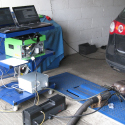Task Force 1 deals with requirements on particulate trap systems, oxidation catalysts and combined systems in respect to material, cross sensitivity, application possibilities and application limits, measures for the systems functionality, OBD requirements, long term stability as well as maintenance. Another task is the specification of test requirements for exhaust measurement technology for EURO 6/VI and level IV.
The focuses of this task force are the analysis of development trends in the fields of measurement and processes technology for limited pollutants, measurement of particles, measurement procedures for gaseous pollutants and system related secondary emissions as well as mobile exhaust measurement technology. Besides general testing and evaluation of new measurement methods it addresses to special requirements on on-board exhaust measurement procedures and its possibility for OBD usage. Further important issues of the task forces are exhaust sensors (PM-sensor, H2S, etc.) and sensors for the monitoring of secondary emissions. A project on PM-sensors was concluded by the FAD e.V.
This task force develops test procedures for different application areas of exhaust after-treatment systems and evaluation criteria for exhaust after-treatment systems, e.g. particulate filter systems, particle reduction systems, DeNOX-systems and combined systems. An important achievement of its work is the development of a test procedure for the FAD-Quality Seal and the development of quality criteria. In future it will update test regulations for the FAD-Quality Seal and process corresponding technical issues.
The working group carries out systematic analysis, information gathering and the exchange of experience regarding the new requirements for operating materials. Studies and projects are also initiated and carried out. The working group concentrates on on the following topics: Analysis and evaluation of the fuel qualities and relevant fuels worldwide, recording of alternative fuels, parameters influencing RDE, compatibility of the fuels with each other and with the engine hardware, suggestions for legislation and standardization, adaptation of the AGN systems to new fuels, new fields of application for AGN systems, requirements for fuel detection for mobile applications and creation of usage concepts. This broad range of tasks is summarized in the following subject areas:
- CO2 reduction
- Drive technologies and their requirements for fuels
- new fuels
- RDE











